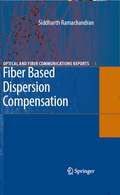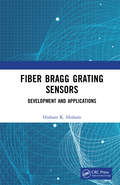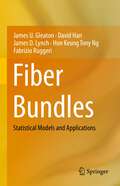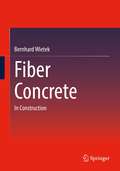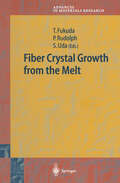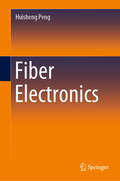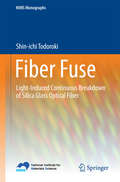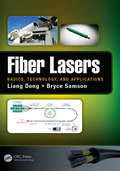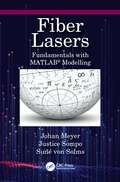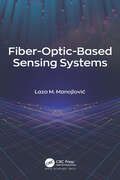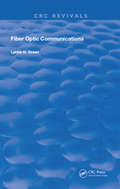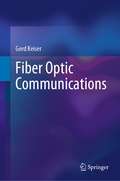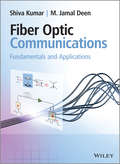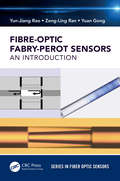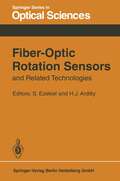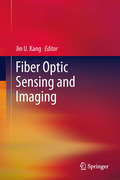- Table View
- List View
Fiber Based Dispersion Compensation (Optical and Fiber Communications Reports #5)
by Siddharth RamachandranIn three well-organized sections, this book offers the first detailed survey of dispersion compensating fibers. The sections outline Conventional Dispersion Compensating Fiber, including a chapter on modeling dispersion in optical fibers; Alternative and Emerging Technologies, including control of dispersion in photonic crystal fibers; and Systems experiments and Impacts, featuring a survey of systems experiments demonstrating Dispersion Compensation Technologies.
Fiber Bragg Grating Sensors: Development and Applications
by Hisham K. HishamThis book presents the basic principles of optical sensor technology in line with the tremendous development in the concept of optical fibers. In the first four chapters, the book discusses the basic principles of optical sensor technology in a simplified manner, making it suitable for all levels of study and research. The seven remaining chapters are concerned with the practical applications of optical sensor technology in all fields such as oil and gas, civil engineering, medical and military fields and harsh environments.
Fiber Bragg Grating Sensors: Development and Applications
by Hisham K. HishamThis book presents the basic principles of optical sensor technology in line with the tremendous development in the concept of optical fibers. In the first four chapters, the book discusses the basic principles of optical sensor technology in a simplified manner, making it suitable for all levels of study and research. The seven remaining chapters are concerned with the practical applications of optical sensor technology in all fields such as oil and gas, civil engineering, medical and military fields and harsh environments.
Fiber Bundles: Statistical Models and Applications
by James U. Gleaton David Han James D. Lynch Hon Keung Ng Fabrizio RuggeriThis book presents a critical overview of statistical fiber bundle models, including existing models and potential new ones. The authors focus on both the physical and statistical aspects of a specific load-sharing example: the breakdown for circuits of capacitors and related dielectrics. In addition, they investigate some areas of open research.This book is designed for graduate students and researchers in statistics, materials science, engineering, physics, and related fields, as well as practitioners and technicians in materials science and mechanical engineering.
Fiber Concrete: In Construction
by Bernhard WietekThis new edition of the book helps the user to correctly use fiber-reinforced concrete as a building material in accordance with its properties in order to create a long-lasting building to create a long-lasting building for the client at low cost. The chapters on chapters on the properties, design and processing of fiber-reinforced concrete.Fiber-reinforced concrete as an extension of concrete offers considerable advantages for building practice, which, based on the material properties, allow a very long service life.Fiber-reinforced concrete is particularly suitable for an aggressive environment such as salt exposure, since corrosion can be completely avoided.Particular attention is also paid to the shrinkage cracks that occur in the concrete and how they can be and how these can be avoided when using fibers.Fiber-reinforced concrete, with its material properties, acts over the entire cross section cross-section in the non-cracked state and thus also offers protection against internal protection against internal destruction. It is a building material that achieves its full static effect in the non-cracked state similar to most other building materials such as wood, steel, glass, etc.This book is a translation of the original German 3rd edition Faserbeton by Bernhard Wietek, published by Springer Fachmedien Wiesbaden GmbH, part of Springer Nature in 2020. The translation was done with the help of artificial intelligence (machine translation by the service DeepL.com). A subsequent human revision was done primarily in terms of content, so that the book will read stylistically differently from a conventional translation. Springer Nature works continuously to further the development of tools for the production of books and on the related technologies to support the authors.
Fiber Crystal Growth from the Melt (Advances in Materials Research #6)
by Tsuguo Fukuda Peter Rudolph Satoshi UdaFiber Crystal Growth from the Melt reviews the growth, modelling, characterization and application of single crystal fibers. Due to their very large length-to-diameter ratio together with perfect crystallographic structure and chemical homogeneity, such fibers have mechanical and physical properties that approach the theoretical values. Fukuda explains how their ultra-high strength enables their application as reinforcing agents in structural components. And he elucidates how and why fiber crystals are particularly well suited for wave guiding, tunable narrow-band filters and nonlinear optics and for the generation of green, blue and violet wavelenghts, and also as micro lasers and laser modulators.
Fiber Electronics
by Huisheng PengThis book highlights the main advances in fiber electronics, like fiber-shaped solar cells, batteries, supercapacitors, sensors, light-emitting devices, memristors and communication devices from the standpoints of material synthesis, structure design and property enhancement. It focuses on revealing the separation and transport mechanisms of charges, establishing transport equations for electrons and ions, and emphasizing integration methods in fiber devices. In closing, it reviews emerging applications based on fiber devices that could accelerate their large-scale production in the near future. Given its scope, the book offers a valuable resource for scientists, engineers, graduate students and undergraduate students in a wide variety of fields such as advanced materials, energy, electrochemistry, applied physics, nanoscience and nanotechnology, polymer science and engineering and biomedical science. It also benefits many non-specialist industrialists who are working to promote new technologies.
Fiber Fuse: Light-Induced Continuous Breakdown of Silica Glass Optical Fiber (NIMS Monographs)
by Shin-ichi TodorokiThis book describes the fiber fuse phenomenon that causes a serious problem for the present optical communication systems. High-power light often brings about catastrophic damage to optical devices. Silica glass optical fibers with ultralow transmission loss are not the exception. A fiber fuse appears in a heated region of the fiber cable delivering a few watts of light and runs toward the light source destroying its core region. Understanding this phenomenon is a necessary first step in the development of future optical communication systems. This book provides supplementary videos and photographs to help understand what occurs in the fiber, including the classification of its propagation mode and self-pumping effect. These findings are good references for other optical devices exposed to ultrahigh-power light such as laser emitters.
Fiber Lasers: Basics, Technology, and Applications
by Liang Dong Bryce SamsonThe fiber laser, with its humble beginning in the late 1980s, has undergone tremendous development in the past decade or so, transforming itself from a research curiosity to a major force in modern manufacturing. Today, it is revolutionizing our economy by fundamentally changing the way we mark, machine, and process materials on an industrial scale. The recent development of high-power fiber lasers is also fundamentally shaping a wide range of other areas from physical sciences and medicine to geology and space exploration. In the past few years, the tactical deployment of direct energy weapons based on fiber lasers has become a reality. The development of fiber lasers is rooted in a number of technical areas including optical materials, optical waveguide design, nonlinear optics, optical fiber fabrication, and optical characterization, in addition to optical fiber components, and fiber laser design and architecture. No comprehensive in-depth coverage of such diverse topical areas has appeared in a single book. Many important developments have taken place in the past decade in both academia and industry. This book comprehensively covers the basics, technology and applications of fiber lasers including up-to-date developments in both academia and industry and is aimed to serve as both an introduction and research aid for graduate students, engineers, and scientists who are new to this field and also for veterans in the field
Fiber Lasers: Basics, Technology, and Applications
by Liang Dong Bryce SamsonThe fiber laser, with its humble beginning in the late 1980s, has undergone tremendous development in the past decade or so, transforming itself from a research curiosity to a major force in modern manufacturing. Today, it is revolutionizing our economy by fundamentally changing the way we mark, machine, and process materials on an industrial scale. The recent development of high-power fiber lasers is also fundamentally shaping a wide range of other areas from physical sciences and medicine to geology and space exploration. In the past few years, the tactical deployment of direct energy weapons based on fiber lasers has become a reality. The development of fiber lasers is rooted in a number of technical areas including optical materials, optical waveguide design, nonlinear optics, optical fiber fabrication, and optical characterization, in addition to optical fiber components, and fiber laser design and architecture. No comprehensive in-depth coverage of such diverse topical areas has appeared in a single book. Many important developments have taken place in the past decade in both academia and industry. This book comprehensively covers the basics, technology and applications of fiber lasers including up-to-date developments in both academia and industry and is aimed to serve as both an introduction and research aid for graduate students, engineers, and scientists who are new to this field and also for veterans in the field
Fiber Lasers: Fundamentals with MATLAB® Modelling
by Johan Meyer Suné Von Solms Justice SompoOver the past two decades, the use of fiber lasers in engineering applications has gradually become established as an engineering discipline on its own. The development of fiber lasers is mainly the result of studies from various domains like photonics, optical sensing, fiber optics, nonlinear optics, and telecommunication. Though many excellent books exist on each of these subjects, and several have been written specifically to address lasers and fiber lasers, it is still difficult to find one book where the diverse core of subjects that are central to the study of fiber laser systems are presented in simple and straight forward way. Fiber Lasers: Fundamentals with MATLAB Modelling, is an introduction to the fundamentals of fiber lasers. It provides clear explanations of physical concepts supporting the field of fiber lasers. Fiber lasers’ characteristics are analyzed theoretically through simulations derived from numerical models. The authors cover fundamental principles involved in the generation of laser light through both continuous-wave (CW) and pulsing. It also covers experimental configuration and characterization for both CW and Q-switching. The authors describe the simulation of fiber laser systems and propose numerical modelling of various fiber laser schemes. MATLAB® modelling and numerical computational methods are used throughout the book to simulate different fiber laser system configurations. This book will be highly desirable and beneficial for both academics and industry professionals to have ample examples of fiber laser approaches that are well thought out and fully integrated with the subjects covered in the text. This book is written to address these needs.
Fiber Lasers: Fundamentals with MATLAB® Modelling
by Johan Meyer Suné Von Solms Justice Mpoyo SompoOver the past two decades, the use of fiber lasers in engineering applications has gradually become established as an engineering discipline on its own. The development of fiber lasers is mainly the result of studies from various domains like photonics, optical sensing, fiber optics, nonlinear optics, and telecommunication. Though many excellent books exist on each of these subjects, and several have been written specifically to address lasers and fiber lasers, it is still difficult to find one book where the diverse core of subjects that are central to the study of fiber laser systems are presented in simple and straight forward way. Fiber Lasers: Fundamentals with MATLAB Modelling, is an introduction to the fundamentals of fiber lasers. It provides clear explanations of physical concepts supporting the field of fiber lasers. Fiber lasers’ characteristics are analyzed theoretically through simulations derived from numerical models. The authors cover fundamental principles involved in the generation of laser light through both continuous-wave (CW) and pulsing. It also covers experimental configuration and characterization for both CW and Q-switching. The authors describe the simulation of fiber laser systems and propose numerical modelling of various fiber laser schemes. MATLAB® modelling and numerical computational methods are used throughout the book to simulate different fiber laser system configurations. This book will be highly desirable and beneficial for both academics and industry professionals to have ample examples of fiber laser approaches that are well thought out and fully integrated with the subjects covered in the text. This book is written to address these needs.
Fiber-Optic-Based Sensing Systems
by Lazo M. ManojlovićThe need for both intrinsic and extrinsic fiber-optic sensor technologies continues to grow. To meet the demands of this fast-expanding applications-driven market, this book discusses both the latest advances and recent application opportunities along with the basic optical phenomena, with the main emphasis on applying optical knowledge for solving real-life engineering problems. Key features of the book:• Highlights the uniqueness of fiber-optics sensors• Presents state-of-the-art technology in optical fiber sensors• Discusses a variety of fiber-optic topologies• Considers different detection techniques• Gives special attention to distributed fiber-optic sensing systems Basic tools and concepts are presented in the earlier chapters, which are then developed in more detail in the later chapters. The book is organized in seven chapters covering a broad range of fiber-optical sensing phenomena. Written for undergraduate and graduate students who want to broaden their knowledge of fiber-optic sensing system applications for real-life engineering problems, the volume is also valuable for engineers who want to acquire the basic principles of optics, especially fiber-optics.
Fiber-Optic-Based Sensing Systems
by Lazo M. ManojlovićThe need for both intrinsic and extrinsic fiber-optic sensor technologies continues to grow. To meet the demands of this fast-expanding applications-driven market, this book discusses both the latest advances and recent application opportunities along with the basic optical phenomena, with the main emphasis on applying optical knowledge for solving real-life engineering problems. Key features of the book:• Highlights the uniqueness of fiber-optics sensors• Presents state-of-the-art technology in optical fiber sensors• Discusses a variety of fiber-optic topologies• Considers different detection techniques• Gives special attention to distributed fiber-optic sensing systems Basic tools and concepts are presented in the earlier chapters, which are then developed in more detail in the later chapters. The book is organized in seven chapters covering a broad range of fiber-optical sensing phenomena. Written for undergraduate and graduate students who want to broaden their knowledge of fiber-optic sensing system applications for real-life engineering problems, the volume is also valuable for engineers who want to acquire the basic principles of optics, especially fiber-optics.
Fiber Optic Communications (Routledge Revivals)
by Lynne D. GreenFirst published in 1993: This book is an outgrowth of fiber optic design courses given by the author.
Fiber Optic Communications (Routledge Revivals)
by Lynne D. GreenFirst published in 1993: This book is an outgrowth of fiber optic design courses given by the author.
Fiber Optic Communications
by Gerd KeiserThis book highlights the fundamental principles of optical fiber technology required for understanding modern high-capacity lightwave telecom networks. Such networks have become an indispensable part of society with applications ranging from simple web browsing to critical healthcare diagnosis and cloud computing. Since users expect these services to always be available, careful engineering is required in all technologies ranging from component development to network operations. To achieve this understanding, this book first presents a comprehensive treatment of various optical fiber structures and diverse photonic components used in optical fiber networks. Following this discussion are the fundamental design principles of digital and analog optical fiber transmission links. The concluding chapters present the architectures and performance characteristics of optical networks.
Fiber Optic Communications: Fundamentals and Applications (Optical And Fiber Communications Reports #7)
by Shiva Kumar M. Jamal DeenFiber-optic communication systems have advanced dramatically over the last four decades, since the era of copper cables, resulting in low-cost and high-bandwidth transmission. Fiber optics is now the backbone of the internet and long-distance telecommunication. Without it we would not enjoy the benefits of high-speed internet, or low-rate international telephone calls. This book introduces the basic concepts of fiber-optic communication in a pedagogical way. The important mathematical results are derived by first principles rather than citing research articles. In addition, physical interpretations and real-world analogies are provided to help students grasp the fundamental concepts. Key Features: Lucid explanation of key topics such as fibers, lasers, and photodetectors. Includes recent developments such as coherent communication and digital signal processing. Comprehensive treatment of fiber nonlinear transmission. Worked examples, exercises, and answers. Accompanying website with PowerPoint slides and numerical experiments in MATLAB. Intended primarily for senior undergraduates and graduates studying fiber-optic communications, the book is also suitable as a professional resource for researchers working in the field of fiber-optic communications.
Fiber Optic Communications: Fundamentals and Applications
by Shiva Kumar M. Jamal DeenFiber-optic communication systems have advanced dramatically over the last four decades, since the era of copper cables, resulting in low-cost and high-bandwidth transmission. Fiber optics is now the backbone of the internet and long-distance telecommunication. Without it we would not enjoy the benefits of high-speed internet, or low-rate international telephone calls. This book introduces the basic concepts of fiber-optic communication in a pedagogical way. The important mathematical results are derived by first principles rather than citing research articles. In addition, physical interpretations and real-world analogies are provided to help students grasp the fundamental concepts. Key Features: Lucid explanation of key topics such as fibers, lasers, and photodetectors. Includes recent developments such as coherent communication and digital signal processing. Comprehensive treatment of fiber nonlinear transmission. Worked examples, exercises, and answers. Accompanying website with PowerPoint slides and numerical experiments in MATLAB. Intended primarily for senior undergraduates and graduates studying fiber-optic communications, the book is also suitable as a professional resource for researchers working in the field of fiber-optic communications.
Fiber-Optic Fabry-Perot Sensors: An Introduction (Series in Fiber Optic Sensors)
by Yun-Jiang Rao Zeng-Ling Ran Yuan GongThe authors deliver a complete overview of fiber-optic Fabry-Perot (FFP) sensing technology, integrating the knowledge and tools of multiple fields including optics, sensing, micromachining, instrumentation, physics, and materials science. The main chapters discuss operating principles, microstructures, fabrication methods, signal demodulation, and instrumentation. This treatment spans the full range of structures (intrinsic/extrinsic, multimode fiber vs single-mode fibers), as well as advanced micromachining technologies and major interrogating and multiplexing methods for the formation of multi-point, quasi-distributed sensing networks. Readers will also gain a summary of state-of-the-art applications in oil, gas, and electricity industries, aerospace technology, and biomedicine. Yun-Jiang Rao is Dean of the School of Communication & Information Engineering, and Director of the Key Lab of Optical Fiber Sensing & Communications at the University of Electronic Science and Technology of China. Zeng-Ling Ran and Yuan Gong are both associate professors at the Optical Fiber Technology Research Laboratory of the University of Electronic Science and Technology of China.
Fiber-Optic Fabry-Perot Sensors: An Introduction (Series in Fiber Optic Sensors)
by Yun-Jiang Rao Zeng-Ling Ran Yuan GongThe authors deliver a complete overview of fiber-optic Fabry-Perot (FFP) sensing technology, integrating the knowledge and tools of multiple fields including optics, sensing, micromachining, instrumentation, physics, and materials science. The main chapters discuss operating principles, microstructures, fabrication methods, signal demodulation, and instrumentation. This treatment spans the full range of structures (intrinsic/extrinsic, multimode fiber vs single-mode fibers), as well as advanced micromachining technologies and major interrogating and multiplexing methods for the formation of multi-point, quasi-distributed sensing networks. Readers will also gain a summary of state-of-the-art applications in oil, gas, and electricity industries, aerospace technology, and biomedicine. Yun-Jiang Rao is Dean of the School of Communication & Information Engineering, and Director of the Key Lab of Optical Fiber Sensing & Communications at the University of Electronic Science and Technology of China. Zeng-Ling Ran and Yuan Gong are both associate professors at the Optical Fiber Technology Research Laboratory of the University of Electronic Science and Technology of China.
Fiber-Optic Rotation Sensors and Related Technologies: Proceedings of the First International Conference MIT, Cambridge, Mass., USA, November 9–11, 1981 (Springer Series in Optical Sciences #32)
by S. Ezekiel H. J. ArdittyCurrently there is considerable interest in the application of optical meth ods for the measurement of absolute rotation. Active approaches, so-called ring laser gyros, have been under serious development for at least 15 years. More recently, passive approaches using ring resonators or multi turn fiber interferometers have also demonstrated much pro~ise. The only previous conference devoted exclusively to optical rotation sensors, held in 1978 in San Diego, California, was organized by the Society of Photo-optical Instru mentation Engineers(S.P.I.E.J. Although the main emphasis at that conference was on ring laser gyros, a number of papers were also included that described the early development of fiber gyroscopes. Since then the field of fiber optic rotation sensors has grown so rapidly that a conference devoted primarily to this subject was needed. The First International Conference on Fiber-Optic Rotation Sensors was held at the Massachusetts Institute of Technology, Cambridge, Massachusetts, Nove~ ber 9-11, 1981. The purpose of the conference was to bring together the ~any researchers and interested personnel from universities, industry, and govern ment to discuss and exchange ideas on the many recent developments in fiber optic rotation sensors and related technologies. The program consisted of tutorial papers as well as invited and contributed papers.
Fiber Optic Sensing and Imaging
by Jin U. KangThis book is designed to highlight the basic principles of fiber optic imaging and sensing devices. The book provides the readers with a solid foundation in fiber optic imaging and sensing devices. The text begins with an introductory chapter that starts from Maxwell’s equations and ends with the derivation of the basic optical fiber characteristic equations and solutions (i.e. fiber modes). Also covered within are reviews of the most common fiber optic interferometric devices which are the basis for many fiber optic imaging and sensing systems. The author discusses the basics of fiber optic imagers with an emphasis on fiber optic confocal microscope. Including chapters on fiber Bragg grating based sensor and various applications and fiber Sagnac loop based sensors. The book also provides useful forms of device characteristic equations.
Fiber Optic Sensors: Current Status and Future Possibilities (Smart Sensors, Measurement and Instrumentation #21)
by Ignacio R. Matias Satoshi Ikezawa Jesus CorresThis book describes important recent developments in fiber optic sensor technology and examines established and emerging applications in a broad range of fields and markets, including power engineering, chemical engineering, bioengineering, biomedical engineering, and environmental monitoring. Particular attention is devoted to niche applications where fiber optic sensors are or soon will be able to compete with conventional approaches. Beyond novel methods for the sensing of traditional parameters such as strain, temperature, and pressure, a variety of new ideas and concepts are proposed and explored. The significance of the advent of extended infrared sensors is discussed, and individual chapters focus on sensing at THz frequencies and optical sensing based on photonic crystal structures. Another important topic is the resonances generated when using thin films in conjunction with optical fibers, and the enormous potential of sensors based on lossy mode resonances, surface plasmon resonances, and long-range surface exciton polaritons. Detailed attention is also paid to fiber Bragg grating sensors and multimode interference sensors. Each chapter is written by an acknowledged expert in the subject under discussion.
Fiber Optic Sensors (Optical Science and Engineering)
by Shizhuo Yin Paul B. Ruffin Francis T. S. YuThe need for both intrinsic and extrinsic fiber optic sensor technologies continues to grow. To meet the demands of this fast expanding applications-driven market, Fiber Optic Sensors, Second Edition presents both the latest advances in fiber optic sensor technology, such as the application of photonic crystal fibers to fiber optic gyroscopes, and recent application opportunities, including the use of fiber optic sensors as a minimally invasive medical treatment. The new edition of this seminal work highlights the development of fiber optic sensors, while providing an overview of current methods for the construction of high-speed and high-capacity fiber optic systems. Two new chapters cover topics such as femtosecond laser illumination inscription and the growing application sector of fiber optic chemical and biological sensors. Adding significant new material, the book continues to provide a progressive history of each sensor type as well as basic principles and fundamental building blocks for practical applications in the electrical aerospace, defense and manufacturing, smart structure, undersea surveillance, medical, and gas and oil industries.
